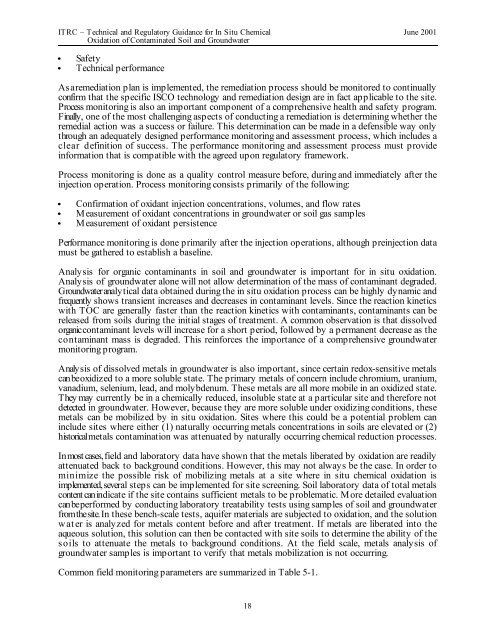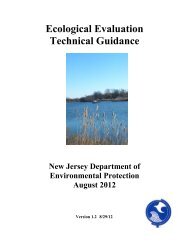Technical and Regulatory Guidance for In Situ Chemical ... - ITRC
Technical and Regulatory Guidance for In Situ Chemical ... - ITRC
Technical and Regulatory Guidance for In Situ Chemical ... - ITRC
Create successful ePaper yourself
Turn your PDF publications into a flip-book with our unique Google optimized e-Paper software.
<strong>ITRC</strong> – <strong>Technical</strong> <strong>and</strong> <strong>Regulatory</strong> <strong>Guidance</strong> <strong>for</strong> <strong>In</strong> <strong>Situ</strong> <strong>Chemical</strong> June 2001<br />
Oxidation of Contaminated Soil <strong>and</strong> Groundwater<br />
C<br />
C<br />
Safety<br />
<strong>Technical</strong> per<strong>for</strong>mance<br />
As a remediation plan is implemented, the remediation process should be monitored to continually<br />
confirm that the specific ISCO technology <strong>and</strong> remediation design are in fact applicable to the site.<br />
Process monitoring is also an important component of a comprehensive health <strong>and</strong> safety program.<br />
Finally, one of the most challenging aspects of conducting a remediation is determining whether the<br />
remedial action was a success or failure. This determination can be made in a defensible way only<br />
through an adequately designed per<strong>for</strong>mance monitoring <strong>and</strong> assessment process, which includes a<br />
clear definition of success. The per<strong>for</strong>mance monitoring <strong>and</strong> assessment process must provide<br />
in<strong>for</strong>mation that is compatible with the agreed upon regulatory framework.<br />
Process monitoring is done as a quality control measure be<strong>for</strong>e, during <strong>and</strong> immediately after the<br />
injection operation. Process monitoring consists primarily of the following:<br />
C<br />
C<br />
C<br />
Confirmation of oxidant injection concentrations, volumes, <strong>and</strong> flow rates<br />
Measurement of oxidant concentrations in groundwater or soil gas samples<br />
Measurement of oxidant persistence<br />
Per<strong>for</strong>mance monitoring is done primarily after the injection operations, although preinjection data<br />
must be gathered to establish a baseline.<br />
Analysis <strong>for</strong> organic contaminants in soil <strong>and</strong> groundwater is important <strong>for</strong> in situ oxidation.<br />
Analysis of groundwater alone will not allow determination of the mass of contaminant degraded.<br />
Groundwater analytical data obtained during the in situ oxidation process can be highly dynamic <strong>and</strong><br />
frequently shows transient increases <strong>and</strong> decreases in contaminant levels. Since the reaction kinetics<br />
with TOC are generally faster than the reaction kinetics with contaminants, contaminants can be<br />
released from soils during the initial stages of treatment. A common observation is that dissolved<br />
organic contaminant levels will increase <strong>for</strong> a short period, followed by a permanent decrease as the<br />
contaminant mass is degraded. This rein<strong>for</strong>ces the importance of a comprehensive groundwater<br />
monitoring program.<br />
Analysis of dissolved metals in groundwater is also important, since certain redox-sensitive metals<br />
can be oxidized to a more soluble state. The primary metals of concern include chromium, uranium,<br />
vanadium, selenium, lead, <strong>and</strong> molybdenum. These metals are all more mobile in an oxidized state.<br />
They may currently be in a chemically reduced, insoluble state at a particular site <strong>and</strong> there<strong>for</strong>e not<br />
detected in groundwater. However, because they are more soluble under oxidizing conditions, these<br />
metals can be mobilized by in situ oxidation. Sites where this could be a potential problem can<br />
include sites where either (1) naturally occurring metals concentrations in soils are elevated or (2)<br />
historical metals contamination was attenuated by naturally occurring chemical reduction processes.<br />
<strong>In</strong> most cases, field <strong>and</strong> laboratory data have shown that the metals liberated by oxidation are readily<br />
attenuated back to background conditions. However, this may not always be the case. <strong>In</strong> order to<br />
minimize the possible risk of mobilizing metals at a site where in situ chemical oxidation is<br />
implemented, several steps can be implemented <strong>for</strong> site screening. Soil laboratory data of total metals<br />
content can indicate if the site contains sufficient metals to be problematic. More detailed evaluation<br />
can be per<strong>for</strong>med by conducting laboratory treatability tests using samples of soil <strong>and</strong> groundwater<br />
from the site. <strong>In</strong> these bench-scale tests, aquifer materials are subjected to oxidation, <strong>and</strong> the solution<br />
wat er is analyzed <strong>for</strong> metals content be<strong>for</strong>e <strong>and</strong> after treatment. If metals are liberated into the<br />
aqueous solution, this solution can then be contacted with site soils to determine the ability of the<br />
soils to attenuate the metals to background conditions. At the field scale, metals analysis of<br />
groundwater samples is important to verify that metals mobilization is not occurring.<br />
Common field monitoring parameters are summarized in Table 5-1.<br />
18
















